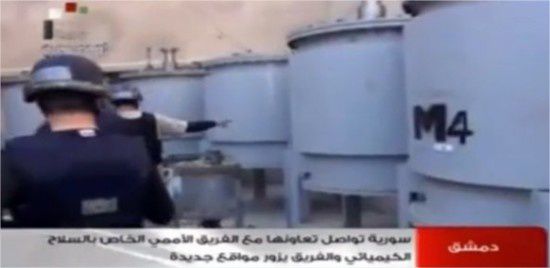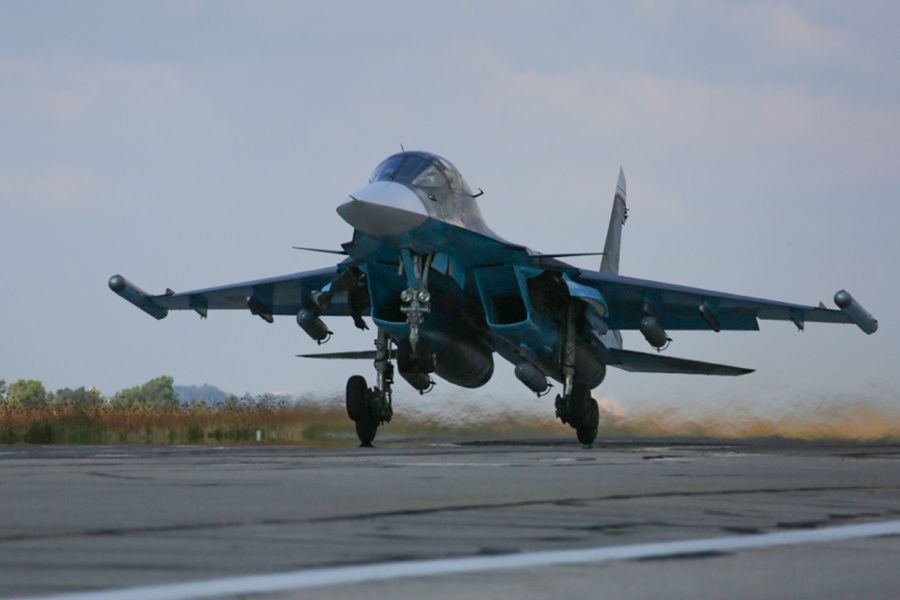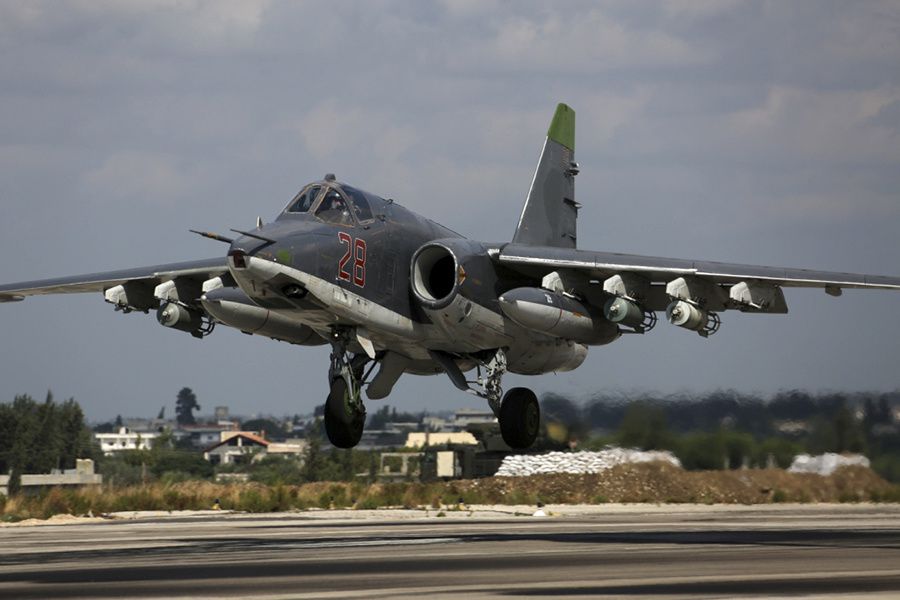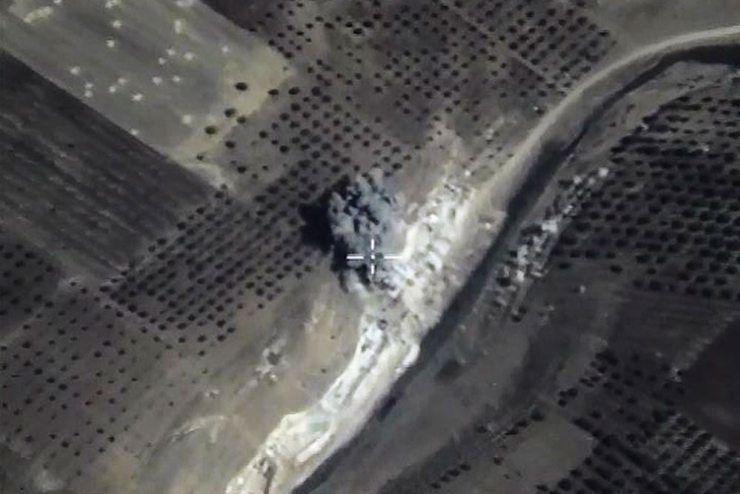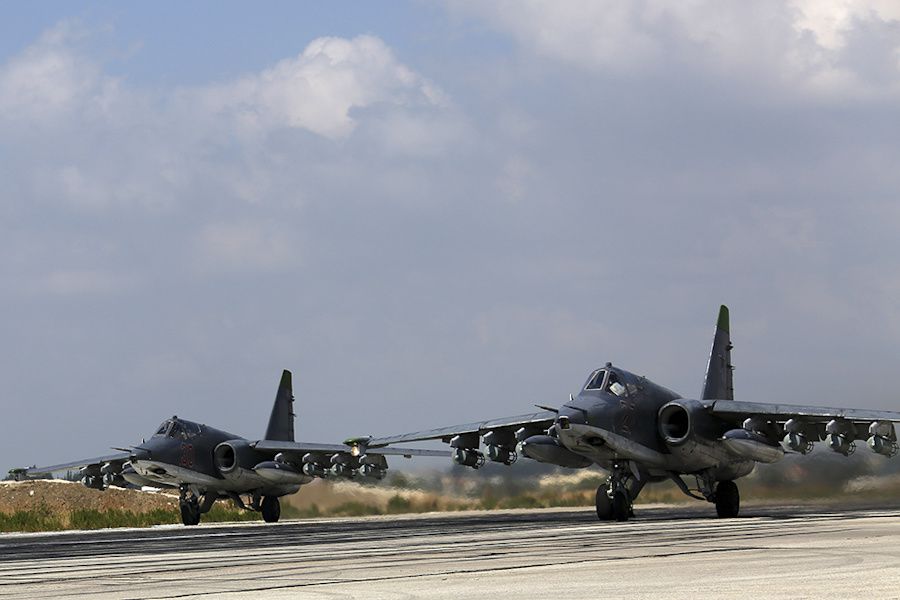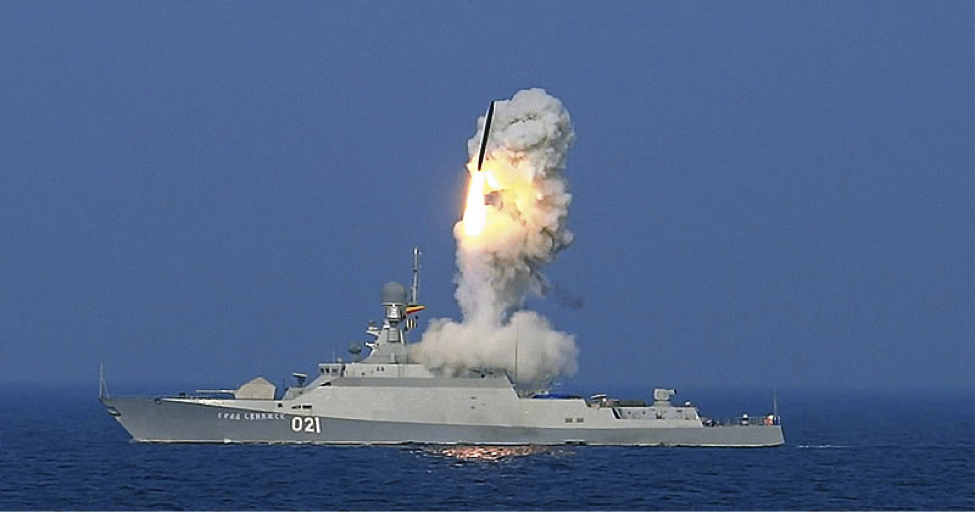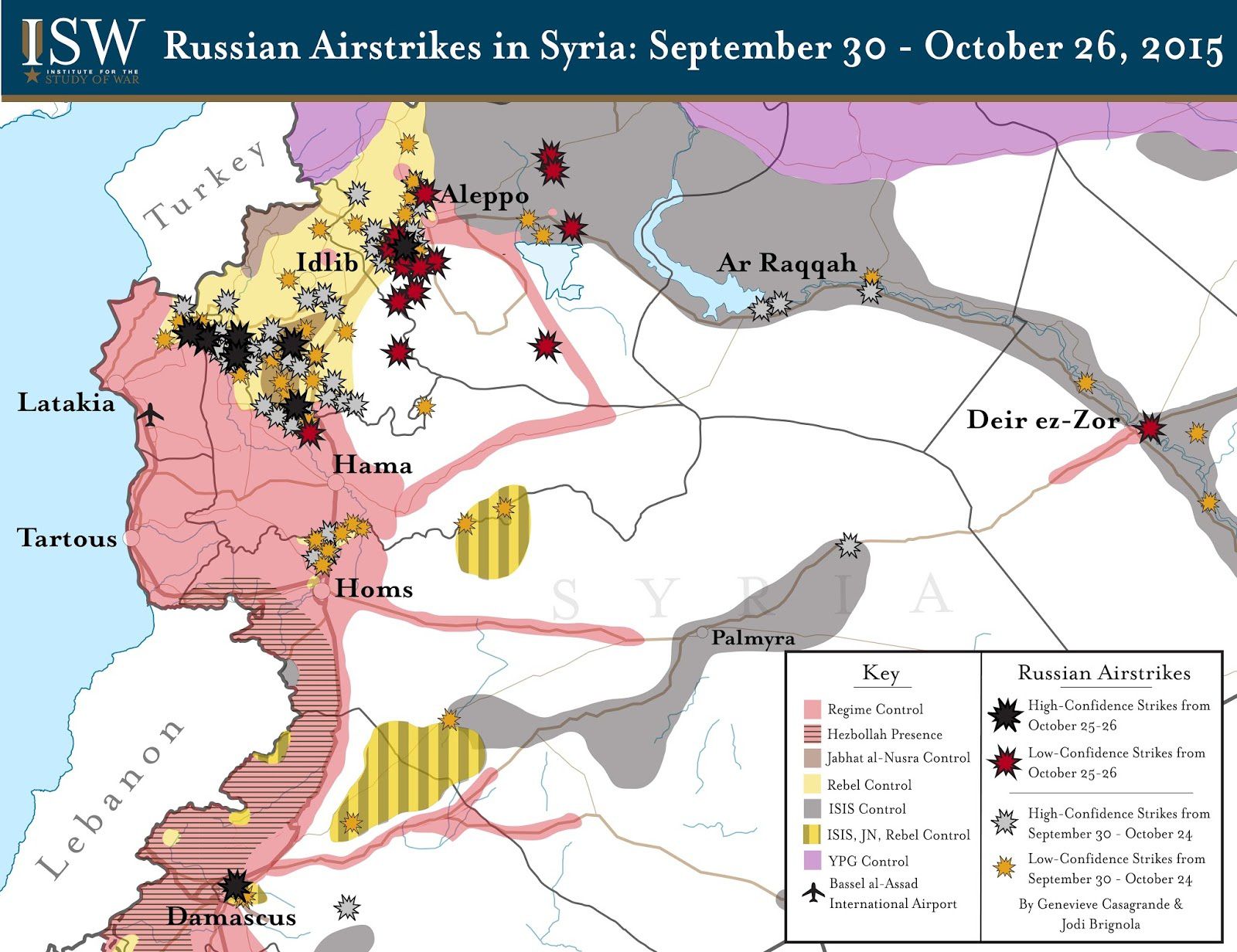Russian Airstrikes in Syria - Sept 30 - Oct 26, 2015 – Credits Genevieve Casagrande ISW
October 27, 2015: Strategy Page
The Russian supported government forces went on the offensive in October and for a week or so seemed to make some progress. The Russian air strikes, guided by Syrian ground controllers, were accurate and allowed the Syrian/Lebanese/Iranian forces to advance. But by mid-October the advance had stalled. There were several reasons for this. First, the rebels were suddenly getting a lot more recruits as many Syrians who were not keen on fighting other Syrians were very eager to “fight the Russians.” Even though there were no (or very few) Russian troops on the ground involved in these operations there were a lot of foreign fighters (mostly recruited, trained, armed and managed by Iran). These included Lebanese from Hezbollah plus Iraqi, Iranian, Afghan and other Shia persuaded (by Iranian cash and other favors) to volunteer for dangerous duty in Shia militias. There were Russians fighting FOR the rebels, but these were mostly Chechens working for ISIL.
The rebels quickly adapted to the Russian tactics by retreating from areas to be bombed and falling back when the Syrian ground forces advanced. Then the rebels came back at night to often regain what had been lost the previous day. This tactic was helped by the sudden arrival of additional TOW anti-tank missiles. These first showed up in early 2014 used by some of the more moderate rebels. Such American arms aid has long been limited because of fears that high-tech weapons would fall into the hands of Islamic terrorist groups and later be used for terror attacks against Westerners. With the arrival of the Russians the U.S. shipped lots (more than a hundred) TOW missiles and this led to the advancing Syrian forces losing up to ten armored vehicles a day. Some of these TOW missiles were delivered by air drop to rebel units in the way of the Syrian advance. Other types of ammunition were also air dropped. Because of a prior arrangement Russian aircraft or anti-aircraft systems did not fire on the U.S. transports.
Russia is also learning the hard way how difficult it is to maintain modern warplanes in the sand and dust of the Middle East. Russia knew about this problem because for decades it had sold military aircraft to countries (including Syria) in the region. But it turned out that there were a lot of (often minor) modifications Syrian maintainers made to their Russian aircraft to keep them operational in this environment. Russian maintainers are working overtime to adapt to all this. Despite that Russia is still getting several sorties a day out of many of the fifty or so warplanes it has in Syria. On some days there are nearly a hundred air strikes. The 50 or so Russian aircraft in Syria consist of Su-34 and Su-30 fighter-bombers, Su-24M bombers and Su-25 ground attack aircraft as well as about a dozen armed helicopters. There are also many transport helicopters.
The Russians have brought in UAVs and electronic monitoring equipment and have a lot better sense of where the best targets are. This has caused a lot of damage to the rebels who find their supply facilities and other support operations being bombed. Russian air strikes in Syria are believed to have left nearly 500 dead so far most (about 70 percent) of them Syrian rebels. Russia officially says it is there to fight ISIL but most of the targets are non-ISIL rebels who have been taking a lot of territory from the Assad government this year. The Russian air strikes have killed at least one senior al Qaeda leader and a senior commander of the FSA (the largest secular rebel group). Both FSA and al Qaeda are hostile to ISIL but for Russia these two groups are a major threat to the Syrian government, which has long been a Russian ally. Russian warplanes are carrying out 50-60 air strikes a day. That is far more than the U.S. led air coalition.
Russia has also made a major effort to help rebuild what is left of the Syrian Air Force, which has suffered enormous (over 70 percent) losses since 2011. Russia has always provided tech and material (spare parts) support for this largely Russian fleet of warplanes and helicopters but not enough for the Syrians to keep more than 30 percent of the 370 aircraft and helicopters operational. The surge of Russian support will mean the Syrian Air Force can be rebuilt and be even more active.
So far the American led air coalition has carried out nearly 7,800 air strikes (64 percent in Iraq and the rest in Syria). The growing number of Syrian and Russian air strikes do not follow the restrictive American ROE (Rules of Engagement) and have been more effective. There are accusations from within the American intelligence community that political leaders are hiding the truth about how the restrictive ROE are crippling the air offensive against ISIL in Iraq and Syria. Another reason for the greater success of Syrian and Russian air strikes is that they have air controllers on the ground to make sure the right target is hit. The American political leadership forbids putting American air controllers on the ground despite the fact that American military commanders believe that the chances of these U.S. troops getting killed or captured is an acceptable risk because it would mean more effective air strikes. Currently the American ROE is obsessed with avoiding any civilian losses from air strikes and ISIL exploits this by regularly using human shields. The locals realize this is counterproductive because the longer ISIL remains operational the more death and misery they bring to the millions of civilians they control.
The Russian supported offensive was concentrating on non-ISIL rebels around Aleppo and in nearby Idlib province. The UN reports that this fighting has driven over 120,000 additional refugees to UN facilities and that has included a growing number of Islamic terrorists who cause all manner of problems in the refugee camps. Some areas around Aleppo were captured by the advancing Syrian forces and held. In addition some key roads in Idlib province were cleared of rebels. Around Aleppo some Russian air strikes are hitting ISIL targets because ISIL is cooperating (and often competing) with other Islamic terrorist rebel groups to take the city. This would have great symbolic value. Otherwise Aleppo is mainly a burden because most of the city center is damaged or destroyed by years of fighting. ISIL is now heavily involved in Aleppo because these areas are close to the Turkish border and that is how smugglers get ISIL supplies across the border and into the hands of ISIL.
The newly captured areas require constant patrolling to keep the rebels out and this is where the newly arrived Russians UAVs have come in handy. To help move the ground offensive forward Russia has sent some of its commandos to Syria. Some of these Russians are coming from months of recent service in eastern Ukraine. Exactly how these will be used is unclear but Iran already has some special operations troops in Syria and they appear to serve mainly for collecting intelligence and attacking key rebel leaders (not always successfully). Iran is providing a lot of trainers, combat advisors and, judging from the number of dead Iranian officers (whose families back in Iran do not hide their grief or keep it out of the media) the Iranians are deeply involved in supervising these offensive operations.
Cuban troops have been reported in Syria, brought in to help train and assist Syrian troops. Some of the Cubans are believed to be special operations (commando) forces. Cuba, Russia and Syria deny the presence of Cuban troops in Syria.
The Russian air strikes had already played a key role in halting rebel advances into the twenty percent of Syria that the Assad forces control. Thus most of the recent Russian air strikes are against targets on the border of Latakia province (where the Syrian ports are) and inside adjacent Hama and Idlib provinces.
This 20 percent of the country is where the pro-Assad population lives and must be held for the Assad clan to retain any legitimacy as the government of Syria. The coastal areas are particularly important because Russia is pouring in military and other supplies via the Assad controlled ports. The roads from there to Damascus and south to the Israeli and Jordan borders must be kept open and the military supplies on these ships helps make that happen.
Russia also approached some rebel groups to propose joint operations against ISIL. These offers all appear to have been rejected. Russia is being depicted as a “foreign invader.” This is a popular attitude in the Middle East. It was used to great effect when Russia invaded Afghanistan in the 1980s and then the U.S. and Britain invaded Iraq in 2003. The Russian aerial and electronic intelligence capabilities plus the informant networks of the Assads has provided the Russians with more information on rebel operations than even the West and neighboring Moslem states have been able to obtain. This enables Russia to make offers like this with some prospects of success. Russia is now able to quickly find out about key rebel casualties (especially the deaths of senior leaders) that the rebels would rather keep quiet (to soften the effect on morale). Russia would like Iran to be more secretive about Iranian generals getting killed in Syria. Six have died there since 2013 and several of those deaths were recent. Syria is a much more dangerous place for Iranian military advisors as only one Iranian general has been killed in Iraq so far.
Despite previously negotiated “deconfliction” agreements with Russia over use of Syrian air space by Israeli and Russian aircraft the agreement proved incapable of dealing with the growing number of Iranian and Russian UAVs operating over Syria. When any of these UAVs get too close to the Israeli (or Turkish) border there is the risk of it getting shot down. This has caused some tension with the Russians as UAVs were apparently not covered in the existing agreements. This is a problem because Russia is working with Iran, which has regularly vowed to destroy Israel and has no agreements with Israel at all. Russia does not want to get dragged into a fight with Israel because of Iranian misbehavior but the Iranians are apparently pressuring the Russians to help “defend” Iranian UAVs operating along the Israeli border. Despite this issue Israel has basically agreed to tolerate Russia (and their Iranian ally) defeating the Syrian rebels and keeping the Assads in power. Israel never liked the Assads but they were able to work with them. At the moment ISIL appears to be the likely winner of a civil war if there is no outside interference. Everyone agrees ISIL control of Syria is the worst outcome and behaves accordingly.
October 25, 2015: Local witnesses said that ISIL destroyed three columns of an ancient temple in central Syria (near Palmyra) with explosives. But first ISIL tied condemned men to each of the columns to execute them (for reasons unknown) along with destroying the ancient “un-Islamic” structure. ISIL took this Syrian site (in Homs province) back in May and since August has been destroying ancient ruins. This was an ancient oasis city that was largely abandoned a century ago and now people live in nearby villages. Palmyra is a major tourist site and it was long feared that ISIL would destroy ruins. But ISIL is also using the ruins as the backdrop of exotic executions that are very effective Internet based recruiting videos. One current video featured a man being executed by running him over with a tank.
Syrian Kurds accuse Turkey of firing on some of their positions in Syria near the Turkish border. Turkey is currently at war with the PKK (Turkish Kurdish separatists) and believes the PYD (the Syrian Kurdish separatists, currently fighting the Assad government) is often working in cooperation with the PKK. The PYD insists it is concentrating on the war in Syria and merely stays in touch with the PKK. Turkey later confirmed the PYD attack claims. Turkey has made it clear that it does not want the Syrian Kurds taking control of large parts of northern Syria.
October 22, 2015: The U.S. has sent a dozen A-10 ground attack aircraft to Turkey to join the force of F-16s that has been used for air strikes on ISIL in Syria. The A-10C can handle smart bombs and thus stay high enough to avoid ground fire but the A-10s are also designed and equipped for low altitude operations. The decision to send the A-10s was made in response to the arrival of Russian warplanes in Syria.
October 21, 2015: Back in Russia the Russian intervention in Syria is portrayed as part of an effort to curb Islamic terrorism inside Russia and appears to have helped. Some 2,000 radicalized Russian Moslems have gone to Syria to join ISIL (Islamic State in Iraq and the Levant) but local officials in areas where most of these Russian recruits come from (the Caucasus, especially Chechnya) point out that Islamic terrorist activity in the Caucasus has declined this year and reports they have received from local informants indicates that most of those who went off to join ISIL have been killed.
October 19, 2015: Turkey said its warplanes had shot down a Russian UAV that had crossed the border into Turkish air space. Russia denied it had lost a UAV. The Turks reminded Russia that piloted Russian aircraft would be shot down as well.
In Syria Russian warplanes bombed a group of FSA rebels, apparently because this group was equipped with American TOW anti-tank missiles, which had been causing a lot of damage to Syrian armored vehicles. The air strikes also killed a senior FSA leader.
Artillery fire against the Russian base at Latakia left three Russians dead and several other wounded. It is unclear if the fire was mortars, artillery or rockets. Russia later denied that any Russians had been killed in Syria.
Many observers were surprised when Russia moved several dozen warplanes to Syria in August and began bombing Syrian rebels with lots of unguided bombs. Since the 1990s the United States has increasingly used smart (laser or GPS) guided bombs and now over 99 percent of American air strikes use such weapons. Other Western nations also adopted smart bombs. Russia is known to have had such weapons since the 1970s, many of them based on American smart bombs (or fragments) captured in Vietnam. The problem was that Russia never built or used a lot of these weapons. For a long time Russia considered these special weapons for rare special occasions.
October 16, 2015: Russia revealed that it had established a “hotline” agreement with Israel so the two nations could quickly resolve any problems between their respective armed forces over Syria.
October 11, 2015: ISIL released, to the Syrian government, fifty Syrian Christians ISIL had kidnapped last August. It is unclear what this was all about. It may have been ransom since ransom has always been a source of income for ISIL, which has very high expenses (supplies, pay and benefits for key people, bribes, fees and rewards for many services).






![Syrian state media says dozens of ISIL fighters were killed in the attack which led to the recapture of Kweires airbase [photo SANA].](http://img.over-blog-kiwi.com/0/54/74/56/20151111/ob_e1cb73_10-11-2015-syrian-state-media-says-doz.jpg)


